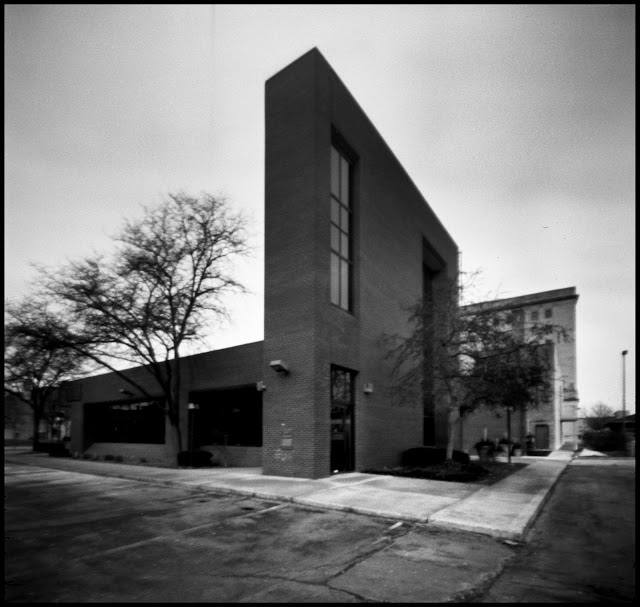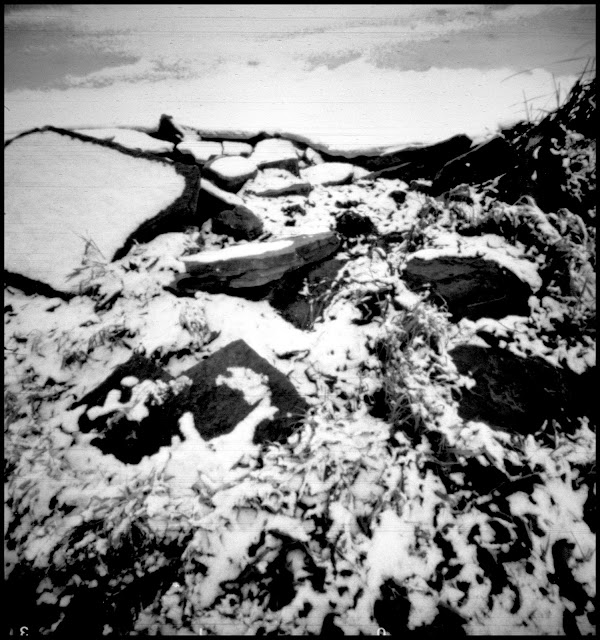For the first roll through the Dragon 30, I wasn't surprised the negatives were covered with scratches when I discovered that I had forgotten to cover the edge that the film rides over with tape. Paper and cardstock are pretty abrasive, which you know if you've ever used anyone's sewing scissors to cut paper. Easily solved, I covered the edge with tape and loaded another roll of Arista.edu 200.
I was pretty surprised when I developed that roll and discovered that the scratches were still there.
The pattern of the scratches, except for the general linearity in the direction of winding, looks pretty random and a bit shorter than I would expect from the normal motion I use to wind film.

I really hate it when something I've done a hundred times turns out different. I've occasionally seen a scratch across a negative but nothing like this. That includes some cameras in which I could barely advance the film. This camera was notably easy to wind. I've also used a squeegee on my film for about a year, which I think has made my negatives much cleaner.
Another odd thing was that where the negative was thinner, the scratches seemed less noticable. They're visible in the sky, but in the darker area at the bottom, there are none to be found.
One negative that was particularly thin showed no sign of the damage at all. Incidentally, Sarah got me this little tin Microbus basically as a wrapper for another gift. Hmmm, what kind of thing do people do with tin boxes?
I had bought four rolls of the Arista.edu 200 at the same time. Two had already been exposed
in the EyePA 30, which is almost exactly the same as the Dragon 30, and
in a 30mm Populist without a hint of this. All the Arista.edu films are rebranded Fomapan. I've used lots of the 100 and an occasional roll of the 400, but this is the first time I've used the 200.
A Google search came up with a discussion forum entry from 2010 which described something that sounded similar with Fomapan 200, with some opinions that the 200 speed stock was particularly vulnerable to this. I had also just opened a new bottle of fixer, which was labeled as non-hardening. I'm pretty sure it's the same stuff as the last bottle. (Arista Premium Odorless Liquid Fixer). Another search turned up an article which said older films required hardening fixer but newer emulsions don't. The other fixer I've used a lot of, Ilford Rapid Fixer, is also a non-hardening fixer. I'm not really familiar with all the ingredients in film emulsions. Could it be that I just happened to get a couple rolls that got the wrong amount of whatever hardening ingredient goes into the gelatin? That would mean my squeegee did it, but it doesn't look like the one continuous stroke when the film comes out of the Photo-flo. My guess is that it happened when the film was coated, and doesn't show up until you try to precipitate a bunch of silver around it.
I had already loaded and partially exposed a roll of FP4+ in a new Compact 45, and decided to swap that roll of film back into the Dragon 30 to see if there was any difference between the two cameras.
To my great relief no scratches of any kind appeared on the FP4+ negatives from either camera. It looks like the Arista.edu 200 was the problem. I wish I had saved the boxes to see if those last two rolls of film were different batches than the first two.
A scene with both over and underexposed areas might offer a clue.
This building looks like it has an incongruously thin slab at the rear but it's actually triangular with the left side pointing directly away from the camera.
From another angle you can see how wide it gets
I don't want to be too critical and have respect for
Fomafoto, and also
Freestyle, who rebrands Foma films as Arista.edu, for their efforts to keep the cost of film down. Except for the notoriously bad reciprocity profiles and the curly negatives, I really like their films.
I've been wrong about things not being my fault before, so I've loaded the camera with Film Photography Project's Mummy 400, which all the reviewers say is rebranded Fomapan. I am going to avoid the Foma 200 though.
One other thing about this camera was the negatives from the first roll were only 55mm wide, which kind of bothered me until I learned that the image on a Hasselblad negative is only 54x54mm. Reworking the film holder got the image out to 57mm, so I'm not doing too bad. I'm going to just keep referring to my cameras as 6x6cm format like everyone else does.
The Dragon 30 has .25mm pinholes, on the axis and 11mm above the axis, 30mm from an ≈6x6cm frame.












































